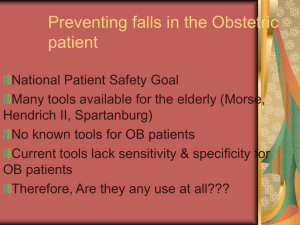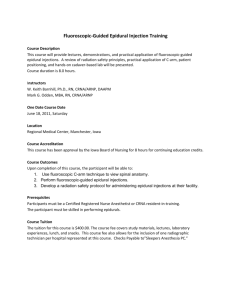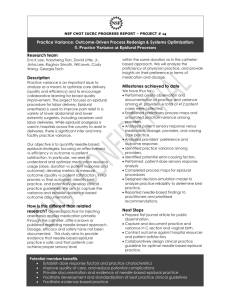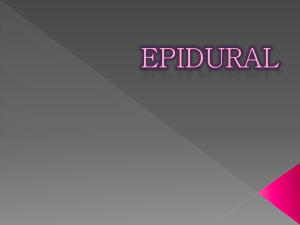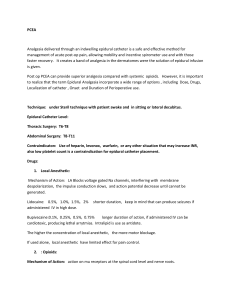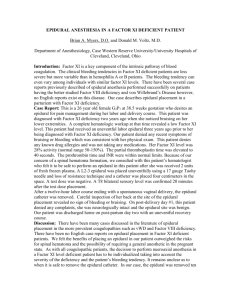click here
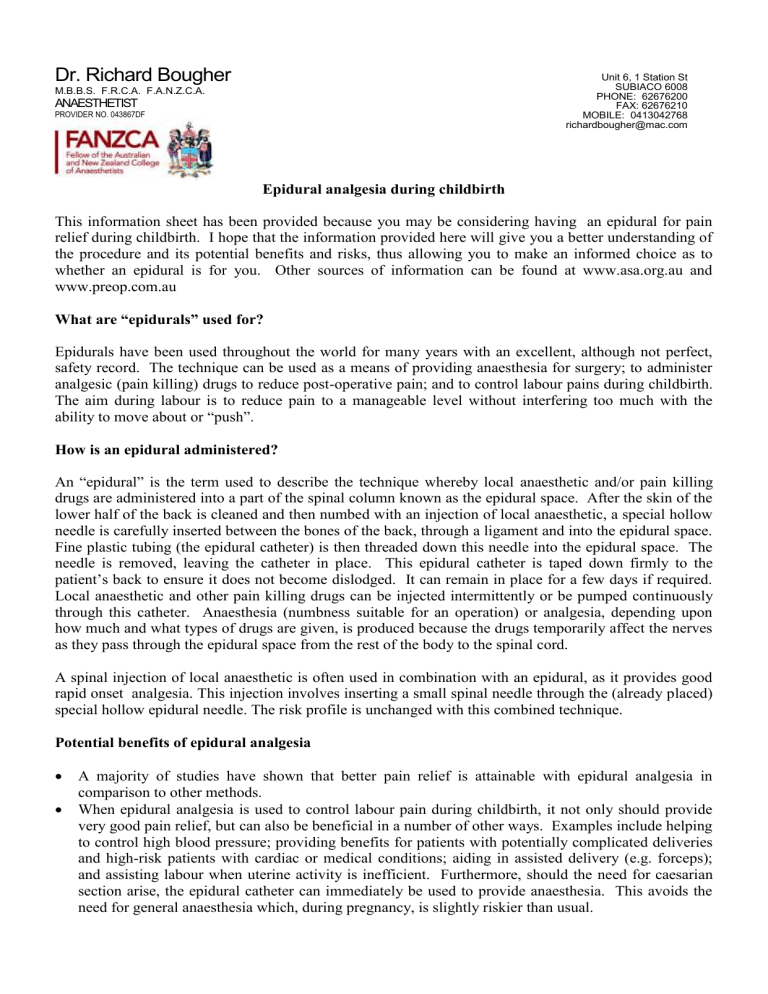
Dr. Richard Bougher
M.B.B.S. F.R.C.A. F.A.N.Z.C.A.
ANAESTHETIST
PROVIDER NO. 043867DF
Unit 6, 1 Station St
SUBIACO 6008
PHONE: 62676200
FAX: 62676210
MOBILE: 0413042768 richardbougher@mac.com
Epidural analgesia during childbirth
This information sheet has been provided because you may be considering having an epidural for pain relief during childbirth. I hope that the information provided here will give you a better understanding of the procedure and its potential benefits and risks, thus allowing you to make an informed choice as to whether an epidural is for you. Other sources of information can be found at www.asa.org.au and www.preop.com.au
What are “epidurals” used for?
Epidurals have been used throughout the world for many years with an excellent, although not perfect, safety record. The technique can be used as a means of providing anaesthesia for surgery; to administer analgesic (pain killing) drugs to reduce post-operative pain; and to control labour pains during childbirth.
The aim during labour is to reduce pain to a manageable level without interfering too much with the ability to move about or “push”.
How is an epidural administered?
An “epidural” is the term used to describe the technique whereby local anaesthetic and/or pain killing drugs are administered into a part of the spinal column known as the epidural space. After the skin of the lower half of the back is cleaned and then numbed with an injection of local anaesthetic, a special hollow needle is carefully inserted between the bones of the back, through a ligament and into the epidural space.
Fine plastic tubing (the epidural catheter) is then threaded down this needle into the epidural space. The needle is removed, leaving the catheter in place. This epidural catheter is taped down firmly to the patient’s back to ensure it does not become dislodged. It can remain in place for a few days if required.
Local anaesthetic and other pain killing drugs can be injected intermittently or be pumped continuously through this catheter. Anaesthesia (numbness suitable for an operation) or analgesia, depending upon how much and what types of drugs are given, is produced because the drugs temporarily affect the nerves as they pass through the epidural space from the rest of the body to the spinal cord.
A spinal injection of local anaesthetic is often used in combination with an epidural, as it provides good rapid onset analgesia. This injection involves inserting a small spinal needle through the (already placed) special hollow epidural needle. The risk profile is unchanged with this combined technique.
Potential benefits of epidural analgesia
A majority of studies have shown that better pain relief is attainable with epidural analgesia in comparison to other methods.
When epidural analgesia is used to control labour pain during childbirth, it not only should provide very good pain relief, but can also be beneficial in a number of other ways. Examples include helping to control high blood pressure; providing benefits for patients with potentially complicated deliveries and high-risk patients with cardiac or medical conditions; aiding in assisted delivery (e.g. forceps); and assisting labour when uterine activity is inefficient. Furthermore, should the need for caesarian section arise, the epidural catheter can immediately be used to provide anaesthesia. This avoids the need for general anaesthesia which, during pregnancy, is slightly riskier than usual.
Potential side effects, complications and risks
Technical problems may occur. It can sometimes, for example, be difficult to locate the epidural space. Incomplete or one sided blockade of pain may occur. Although this situation can usually be remedied, it may sometimes be necessary to re-insert the epidural catheter.
A decrease in blood pressure, especially at the start of an epidural block, may occur and is usually readily treated. This may cause you to feel light-headed, dizzy or nauseated.
Some leg weakness for the duration of the epidural is common and can vary from being almost unnoticeable (in a “walking” epidural) to not being able to move at all.
Headache can be a side effect of an epidural and can occur if the bag of fluid around the spinal cord is punctured. This occurs in approximately 1 in every 100 epidural administrations. In cases where the headache is persistent or severe, successful treatment is very likely through the use of an epidural blood patch.
There has been some concern that the use of epidurals may lead to persistent back pain. There is currently no good evidence to support this. It is quite common to have a bruised feeling for a few days where the epidural was inserted.
Itchiness, bladder emptying problems and nausea can occur. If these effects occur they are generally treatable.
Seizures due to local anaesthetic (1 in 10,000)
A serious potential complication is permanent damage to spinal nerves due to infection (1 in 5,000), haematoma (blood clot), injection of the wrong drug, or interruption of arterial blood supply. This damage can result in patches of numbness, muscle weakness, reduced bladder or bowel function, paraplegia (1 in 100,000) and even death (1 in 200,000). The chance of permanent patches of numbness or weakness is probably less than 1 in 15,000, and that of a spinal haematoma less than 1 in
150,000. The risk of developing such a serious neurological complication is remote when performed by someone who is experienced, and when ongoing care is provided by staff who are experienced in the management of epidurals.
The question as to whether the use of epidural analgesia affects the duration of labour or the mode of delivery is a complex one. Many factors such as obstetric management practices, individual patient preferences, etc. influence these outcomes. Epidural technique and the “mix” of drugs used may also have an influence. Whilst high quality scientific knowledge on this subject remains incomplete, it has been shown that epidurals used in early labour do not prolong the first stage, although there is some evidence for an increase in the need for a subsequent instrumental delivery. The influence of epidural analgesia on the incidence of caesarian section remains disputed, however the effect, if any, is likely to be small compared to that due to differing obstetric practices. With regard to the baby only small amounts of the epidural drugs pass into the baby and these have practically no effect. Limited studies reveal that the use of epidural analgesia is not associated with adverse long term neonatal outcomes.
Recovery from epidural analgesia
The vast majority of patients recover totally uneventfully after epidural analgesia, however you should seek medical advice or contact me (0413042768 or 62676200) if there is:
Severe constant back pain often in association with disturbances of bowel or bladder function, or leg weakness. This may indicate infection in the spinal canal and it may occur up to a few weeks after having had an epidural or spinal. This condition is serious but very rare.
Persistent headache which was not present before the epidural.
Anaesthetic fee
The fee for your labour epidural is separate from those charged by the institution in which the service takes place and other doctors caring for you. This fee has been calculated according to the Australian
Medical Association List of Fees. Depending on what private health insurance you have, there is often a gap between the actual anaesthetic fee which you are required to pay and the amount reimbursed from
Medicare and private health insurance.
